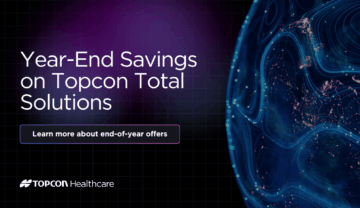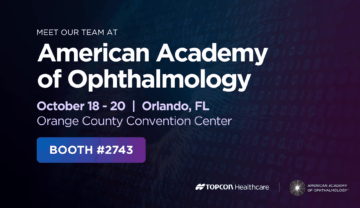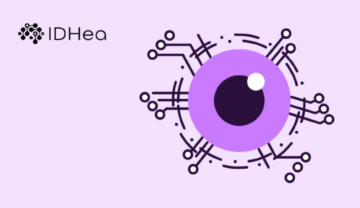
The Next-Generation Refraction System Boosting Accuracy & Efficiency
Your patients and practice deserve accurate and efficient ways of doing refraction.
In our clinic at the New England College of Optometry (NECO), we wanted to incorporate an automated binocular refraction system and chose the Chronos from Topcon Healthcare. At NECO, we are evaluating this technology to better understand how it will allow us to improve workflows and elevate our patient experience.
Chronos combines binocular objective and subjective refraction, keratometry measurements, and visual acuity in a single instrument that occupies a minimal amount of space. The system’s optional SightPilot™ software provides a guided refraction with step-by-step instructions based on the patient’s response (Figure 1) making it easy for an inexperienced operator to use. This allows the clinician to delegate the refraction to a technician and simply confirm the results before prescribing glasses. If the clinician prefers to do their own refraction, the device is able to conduct a standard refraction using the same recognizable layout of a digital phoropter (Figure 2).
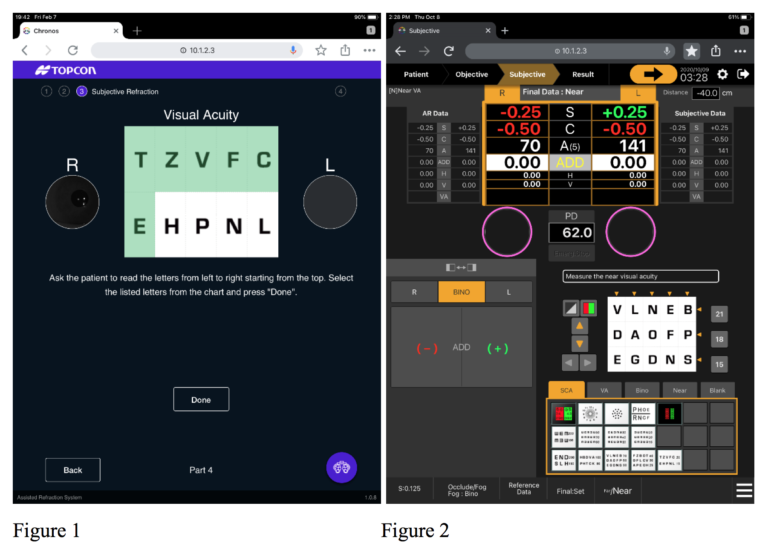
Improved Patient Experience & Accuracy
The ability to obtain an auto-refraction, binocular refraction and visual acuity information with one device without having to move the patient from one instrument to another is a huge advantage. Patients appreciate not having to be moved around, and our staff and clinic benefit from the increased efficiency this allows. On average, providers have been able to complete a patients’ refractions on a set of normal eyes in 3-4 minutes. For a busy, multi-doctor practice, this optimization translates to an additional 5-10 more patients per day. For a smaller practice, it could provide the opportunity to add an additional 2-3 more patients to the daily schedule.
The accuracy of the Chronos in terms of refractive outcomes has been impressive. In some of our early research using the Chronos, we found that 98 percent of patients were refracted within +/- 0.50 diopters of a manual refraction in the phoropter.
Patients are impressed with the speed, experience and accuracy of the binocular refraction, which most have never encountered. Technology like this brands a practice as forward-looking and cutting-edge, differentiating you from other competitive practices in your market.
Economize Space & Expand Patient Accessibility
Chronos has a small footprint, just one square meter (4 square feet) and gives those struggling with space constraints the ability to maximize their diagnostic capabilities by allowing refractions to be performed in a multi-functional space. Additionally, patients with mobility issues have minimal problems utilizing the Chronos and have reported comfort during refraction. Wheelchair patients do not need to be transferred as they are able to come up to the edge of the device and it can be adjusted so they can put their chin directly on the platform while remaining in their wheelchair.
Ideal Technology for an Ongoing Pandemic
The Chronos has enabled our clinic to promote social distancing during the refraction portion of the examination. Providers or technicians have the ability to stand at a distance of greater than six feet from the device while conducting refractions. The refraction performed on the Chronos can also be compared to the previous glasses prescription with the touch of a button, saving time and helping patients make purchasing decisions from a safe distance.
Ease-of-Use that Gives a Practice a Reliable Option for Delegating Refraction
The simplicity of the system, including SightPilot’s guided refraction, makes for a short learning curve. NECO’s second-year students had the opportunity to experience the Chronos device using SightPilot and a standard refraction. During both refraction methods, they were able to quickly work through the refraction process. This ease of use allows the option to delegate and train technicians to perform highly accurate refractions, thus freeing up the doctor’s time to confirm the Rx and focus additional time on the patient in the exam room.
More Time to Focus on Medical Eyecare
With the additional time saved, the doctor now has more time to evaluate the patient for medical eyecare conditions, educate the patient about specific treatment plans and discuss products and services that the practice can provide to improve the patient’s quality of life and safeguard their eye health.
We know that refraction is an important part of the comprehensive exam, but as a profession, we should also continue to look toward expanding and improving our medical eyecare services and other specialties, such as dry eye and myopia management, that improve our patients’ eye health. This is one example of how new innovations can continue to move optometry forward as a vital component of healthcare. It’s a technology that can help us take our patient care and practice into the future.
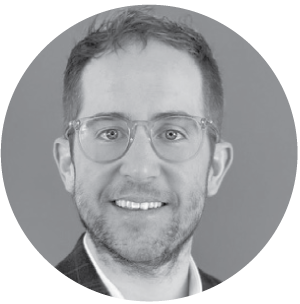
ABOUT THE AUTHOR
Timothy Bossie, OD, is Director of Owned Clinics, & Outreach Services and Attending Optometrist at NECO Center for Eye Care.


